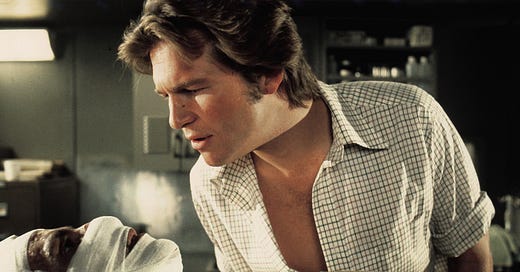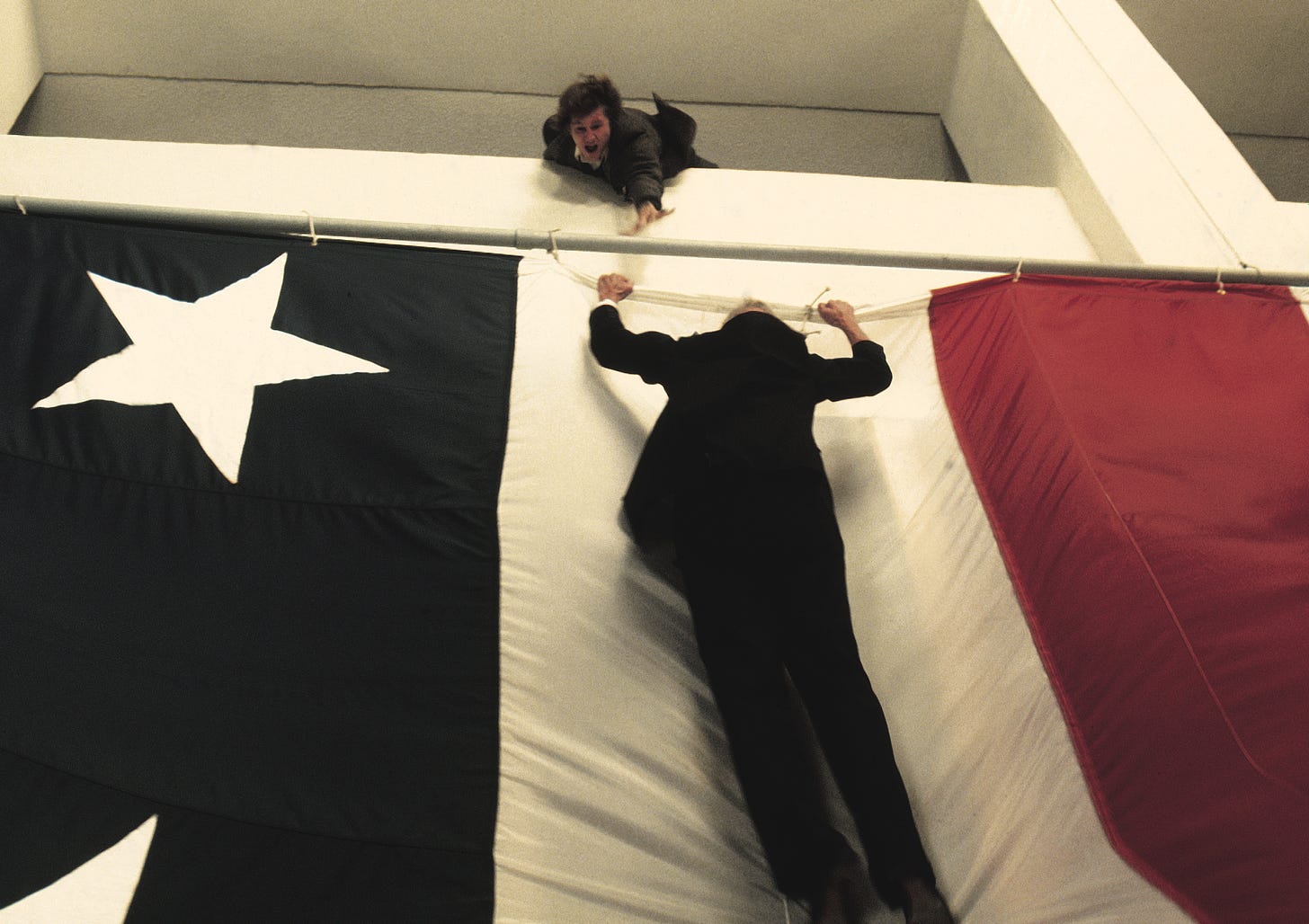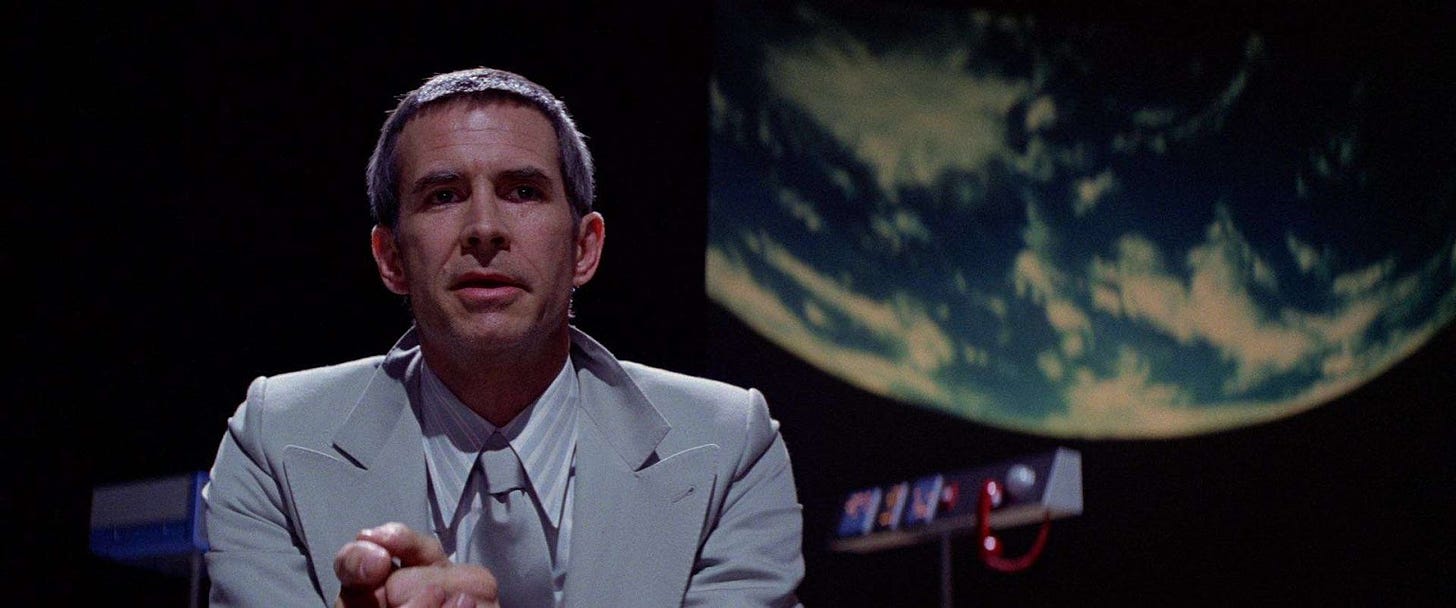The zany, deadly American dystopia of 'Winter Kills'
William Richert's revived cult favorite turns a JFK-like assassination plot into a 'Dr. Strangelove' of broken democracy.
“They will run you dizzy. They will pile falsehood on top of falsehood until you can’t tell a lie from the truth and you won’t even want to. That’s how the powerful keep their power.” — Richard Boone, Winter Kills
Of all the conspiracy theories that have swirled around the JFK assassination, my favorite happens to come from my father, an otherwise sane and rational man who strongly believes that two shooters were firing at the presidential motorcade that afternoon in Dallas. “Oh, the two-shooter theory?”, you might be asking. “Oswald from the book depository and another guy from the grassy knoll? That’s actually a very common theory, shared by many people.” But here’s the twist: My dad believes the two shooters were operating independent of each other. In his words, that spot in Dealey Plaza was just “the best place to shoot him that day.”
I’m reminded of a headline from The Onion’s Our Dumb Century that unified all the conspiracy theories into a one gigantic firing squad: KENNEDY SLAIN BY CIA, MAFIA, CASTRO, LBJ, TEAMSTERS, FREEMASONS. (The dek: President Shot 129 Times from 43 Different Angles.) But what my father proposes is actually a kind of anti-conspiracy theory, in that you have two shooters acting on their own simultaneously, on behalf of organizations or ideologies unknown to us. Whatever the case, it’s a fundamental truth that the JFK assassination—aided, crucially, by the way the Zapruder footage dances on the edge of legibility—ignited the popular imagination, which couldn’t be placated by the Warren Commission. JFK had plenty of enemies, but there was a broader sense, affirmed later by Watergate, that the fate of our democracy was not in our hands but controlled by elite and unaccountable powers.
The bizarre, brilliant, wounded political satire Winter Kills, re-released this week by Rialto Pictures in a newly struck 35mm print, gets to the paranoid heart of the JFK assassination like only a work of fiction could. Even a later film like Oliver Stone’s JFK, which offers an alternate history around Jim Garrison’s investigation of the case, remains tethered to a reality that Winter Kills can either allude to or ignore completely. Working from Richard Condon’s 1974 novel, writer-director William Richert pokes into a presidential assassination that parallels JFK’s, but fantasizes bitterly and hilariously about the rich, decadent lunatics who really run the country and have all the resources in the world to keep the truth from coming out.
The story of how Winter Kills got made and unmade is every bit as byzantine and ridiculous as the movie itself. Though Condon was not involved in the filmmaking process, he greatly admired the finished result and wrote a gripping behind-the-scenes look at the whole fiasco for Harper’s called “Who Killed Winter Kills?” The gist is that the film’s original producers, Robert Sterling and Leonard Goldberg, had neither the experience nor the funds to take it across the finish line, and that when payments to cast and crew—sometimes delivered in envelopes of cash in a hotel room—dried up, the artists worked for free until union officials found out and shut it down. It took two years and money from multiple studios and individuals, including cast members like Jeff Bridges and John Huston, to complete the film. Even then, the distributor, Embassy Pictures, took control over the final cut. The film tanked at the box office—even that part of the story is flummoxing— and Richert only finished it to his liking in 1983, when he acquired the rights to it again.
Watching it now is a revelation, like finding some missing piece that unifies two decades’ worth of American political films. To paraphrase another Bridges movie, it’s a rug that really ties the room together. Condon had written the novel The Manchurian Candidate in 1959, adapted into the John Frankenheimer classic three years later, and there’s a strong connection here about the president as a puppet who’s intended to express the will of a wealthy, sinister parent. A host of other films spring to mind, chiefly 1974’s The Parallax View, the greatest of ’70s paranoid thrillers, also about a politician gunned down by a shadowy organization, and Ivan Passer’s 1981 cult noir Cutter’s Way, also starring Bridges, which has a similar shaggy-dog quality. (As it happens, Richert worked with Passer on the scripts for two of his ‘70s comedies, Law and Disorder and Crime and Passion.)
Despite Richert’s inexperience—and the obvious shadiness of his producers—Winter Kills was able to attract an extraordinary cast: Bridges, Huston, Anthony Perkins, Eli Wallach, Sterling Hayden, Dorothy Malone, Toshiro Mifune, and Ralph Meeker, among others. (Elizabeth Taylor got an uncredited, one-word part for the cost of $100,000 up front and a fur coat that was later seized for lack of payment.) Behind the camera was the legendary cinematographer Vilmos Zsigmond, who had just shot Close Encounters of the Third Kind and The Deer Hunter back to back, which further suggests the scope of Richert’s vision here. Winter Kills was not intended as the offbeat, fringe-y cult item it would eventually become. It was an outsized vision of America that had attracted some of the biggest talent in the filmmaking world.
In February 1960, 19 years before the film opens, President Timothy Kegan was shot by a sniper during an appearance in Philadelphia. An official commission ruled that a single assassin named Willie Arnold was responsible for the shooting, but Arnold was gunned down, Jack Ruby style, by mob-connected nightclub owner Joe Diamond (Wallach). But another man, clinging to life after an accident on an oil tanker, is brought to the former president’s layabout brother Nick (Bridges) and claims, in his dying breaths, that he was the real shooter. He gives Nick the location where he hid the rifle and it checks out, starting an amateur investigation that results in nearly everyone but Nick getting picked off. Who or what entity is responsible for killing all of these witnesses? And why are they sparing Nick?
Suspicion naturally falls on Nick’s megalomaniac father Pa, played by Huston in a performance that registers like a comic echo to his menacing guy-behind-the-guy turn five years earlier in Chinatown. Perfectly anticipating a future where a few billionaires run the world, Winter Kills offers Pa Kegan as one of two men who seem to own absolutely every corporation and business in America, from oil tankers to hospitals to high-end restaurants. (And with surveillance equipment monitoring every one of them.) Pa’s rival is Z.K. Dawson (Hayden), who’s introduced driving one of several tanks on his sprawling ranch property. When Nick pays him a scheduled visit to ask questions about his brother’s death, Dawson gives him 30 seconds to drive off in his economy car before he and his boys start shelling him.
Other possible conspirators emerge, too, from a gangster (Meeker) who didn’t feel like he got a good return on a $2 million mafia campaign investment to an operator acting on behalf of a Hollywood studio that lost as much as $50 million when a movie star who’d been sleeping with President Kegan killed herself after he ended the affair. There’s also some business involving Nick’s mysterious girlfriend Yvette (Belinda Bauer), who claims to be the editor of a national magazine (actually called National Magazine) that could publish his astounding revelations once he has the facts nailed down. But poor Nick is in over his head from the beginning, and his dad seems to revel in watching him on this wild goose chase.
Coherence is not a reasonable expectation of Winter Kills, which does get around to answering the question of who killed Timothy Kegan, but mostly concerns itself with a world in which the biggest truths are the most elusive and indecipherable. Having oligarchs like Pa Kegan and Z.K. Dawson running the country may be a chilling proposition, but Condon and Richert turn it into a broad cosmic joke, like Dr. Strangelove for a failed democracy. Huston looks like he’s having the time of his life as an eccentric boor who has a sentimental attachment to his brass knuckles and regularly admits himself to hospital to get fresh blood from “Amherst kids.” Hayden all but reprises his deranged Jack D. Ripper role from Strangelove and Perkins is a one-scene wonder as the manager of a “contract silo” of infinite information that looks like the bureaucratic hell later imagined in Brazil.
As outrageous as Winter Kills gets at times, its satirical feeling for the zany conspiratorial soul of America feels truer now than it might have in 1979, given the decadence of the country’s richest and most influential players are on full public display. The one place where the left and right are united today is the hostility and paranoia they direct at the “elite” class, and it’s easy for modern viewers to look at men like Kegan and Dawson and slot in figures Jeffrey Epstein or Harlan Crow or Elon Musk or Fred Trump. At one point, Perkins talks about Pa Kegan’s machinations. “Your father put him in the White House,” says Perkins. “Why? Because that’s where you can generate the most cash. A cold-ass business proposition like everything else in this society.”
Sound familiar?
The new 35mm print of Winter Kills, presented by Quentin Tarantino, opens Friday at Film Forum. It then moves to New Beverly in Los Angeles on August 25th.







Why am I a subscriber? Because I didn’t wake up this morning needing a dive on WINTER KILLS but realized I did when this popped up. It’s why I became followers of y’all and the AVC back then. This doesn’t add anything to your piece (which I will luxuriate in later). But wanted to thank you for its sheer existence.
I love conspiracy stories and paranoid thrillers, somehow never even heard of this one until about 5 years ago. Saw that cast and couldn’t believe it was possible for a movie with that cast to be so obscure. Anyway, followed a Parallax View rewatch with Winter Kills, and it’s pretty much a perfect combo. The silliness brings you back from the hopelessness of Parallax, and I couldn’t help wondering which Winter Kills character was responsible for setting up the Parallax Corporation.
It seems almost impossible that the Hayden tank scene isn’t internet famous. It’s Sterling Hayden in a tank, firing on a civilian; I don’t know what people want out of life. Seems pretty great to me.